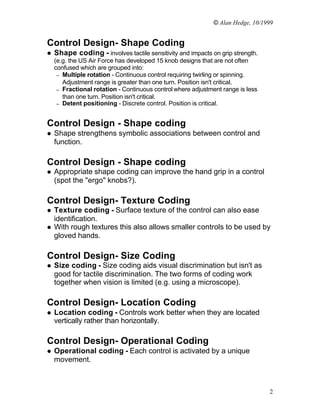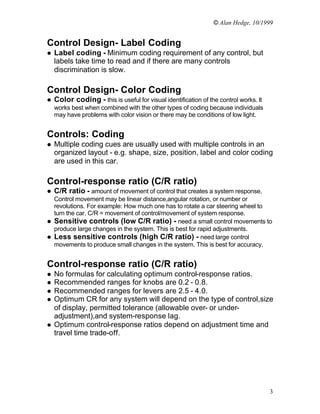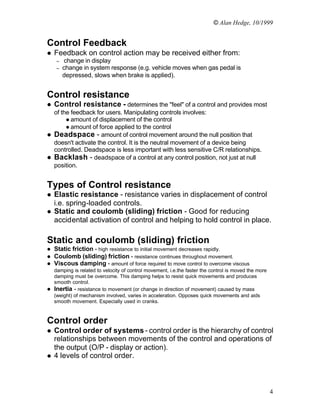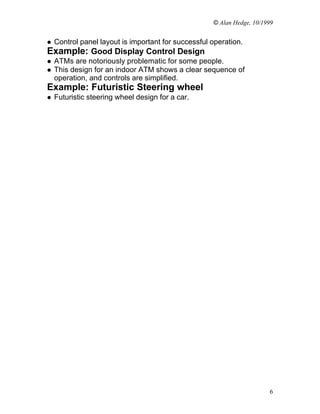Controls
- 1. © Alan Hedge, 10/1999 Controls DEA 325/651 Controls l Controls are a frequent source of system error and failure. Controls - Simplicity in Design l Complex controls invariably can be simplified by ergonomic analysis. Controls l Human Control of Systems - There is an enormous variety of control devices for human-machine systems. Examples range from light switches to complex power plants. l Function of Controls - The primary function of controls is to transmit information from the operator to the system. Feedback on the consequences of an action is crucial to the maintenance of optimal Human-Machine-System performance. Classes of Controls l Discrete - simple and fixed magnitudes of information provided to the system Examples: on/off switch, high/medium/low toggles, detent controls etc. l Continuous - varying level of information provided to the system via the operator including speed, pressure, flow rate, etc. Examples: steering wheels, levers, pedals, etc. Types of Controls l Information type (discrete/continuous) l Action type (e.g. rotary crank, wheel, push/pull) l Actuating force needed (large or small). l Controls as displays (e.g. touch screens). l Cursor positioning (mouses, touchpads). Control Design Considerations l Identification - Control design can increase speed and accuracy of performance. Identification of controls is a coding problem that depends on various factors such as shape, texture, size, color etc. 1
- 2. © Alan Hedge, 10/1999 Control Design- Shape Coding l Shape coding - involves tactile sensitivity and impacts on grip strength. (e.g. the US Air Force has developed 15 knob designs that are not often confused which are grouped into: – Multiple rotation - Continuous control requiring twirling or spinning. Adjustment range is greater than one turn. Position isn't critical. – Fractional rotation - Continuous control where adjustment range is less than one turn. Position isn't critical. – Detent positioning - Discrete control. Position is critical. Control Design - Shape coding l Shape strengthens symbolic associations between control and function. Control Design - Shape coding l Appropriate shape coding can improve the hand grip in a control (spot the "ergo" knobs?). Control Design- Texture Coding l Texture coding - Surface texture of the control can also ease identification. l With rough textures this also allows smaller controls to be used by gloved hands. Control Design- Size Coding l Size coding - Size coding aids visual discrimination but isn't as good for tactile discrimination. The two forms of coding work together when vision is limited (e.g. using a microscope). Control Design- Location Coding l Location coding - Controls work better when they are located vertically rather than horizontally. Control Design- Operational Coding l Operational coding - Each control is activated by a unique movement. 2
- 3. © Alan Hedge, 10/1999 Control Design- Label Coding l Label coding - Minimum coding requirement of any control, but labels take time to read and if there are many controls discrimination is slow. Control Design- Color Coding l Color coding - this is useful for visual identification of the control works. It works best when combined with the other types of coding because individuals may have problems with color vision or there may be conditions of low light. Controls: Coding l Multiple coding cues are usually used with multiple controls in an organized layout - e.g. shape, size, position, label and color coding are used in this car. Control-response ratio (C/R ratio) l C/R ratio - amount of movement of control that creates a system response. Control movement may be linear distance,angular rotation, or number or revolutions. For example: How much one has to rotate a car steering wheel to turn the car. C/R = movement of control/movement of system response. l Sensitive controls (low C/R ratio) - need a small control movements to produce large changes in the system. This is best for rapid adjustments. l Less sensitive controls (high C/R ratio) - need large control movements to produce small changes in the system. This is best for accuracy. Control-response ratio (C/R ratio) l No formulas for calculating optimum control-response ratios. l Recommended ranges for knobs are 0.2 - 0.8. l Recommended ranges for levers are 2.5 - 4.0. l Optimum CR for any system will depend on the type of control,size of display, permitted tolerance (allowable over- or under- adjustment),and system-response lag. l Optimum control-response ratios depend on adjustment time and travel time trade-off. 3
- 4. © Alan Hedge, 10/1999 Control Feedback l Feedback on control action may be received either from: – change in display – change in system response (e.g. vehicle moves when gas pedal is depressed, slows when brake is applied). Control resistance l Control resistance - determines the "feel" of a control and provides most of the feedback for users. Manipulating controls involves: l amount of displacement of the control l amount of force applied to the control l Deadspace - amount of control movement around the null position that doesn't activate the control. It is the neutral movement of a device being controlled. Deadspace is less important with less sensitive C/R relationships. l Backlash - deadspace of a control at any control position, not just at null position. Types of Control resistance l Elastic resistance - resistance varies in displacement of control i.e. spring-loaded controls. l Static and coulomb (sliding) friction - Good for reducing accidental activation of control and helping to hold control in place. Static and coulomb (sliding) friction l Static friction - high resistance to initial movement decreases rapidly. l Coulomb (sliding) friction - resistance continues throughout movement. l Viscous damping - amount of force required to move control to overcome viscous damping is related to velocity of control movement, i.e.the faster the control is moved the more damping must be overcome. This damping helps to resist quick movements and produces smooth control. l Inertia - resistance to movement (or change in direction of movement) caused by mass (weight) of mechanism involved, varies in acceleration. Opposes quick movements and aids smooth movement. Especially used in cranks. Control order l Control order of systems - control order is the hierarchy of control relationships between movements of the control and operations of the output (O/P - display or action). l 4 levels of control order. 4
- 5. © Alan Hedge, 10/1999 Control Order – Zero-order: Position Control - movement of control controls the O/P directly, e.g. moving a flashlight from object to object or tracing or drawing something. – First-order: Rate Control - movement of control changes the rate(velocity) at which O/P is being changed, e.g. auto accelerator or computer mouse. – Second-order: Acceleration Control - movement of control controls the rate of change of O/P, e.g. auto steering wheel (when wheel is turned,front wheels turn and there is a change in the rate of acceleration towards the turning direction). – Higher-order Systems - depend on complexity of linkages, e.g.change in position control creates change in a rate control which leads to a change in acceleration. Example: Poor design l Good use of shape and operational coding (push button, détente). l Poor use of color coding (especially for push buttons). Example: Poor Design l Poorly designed multifunction drive direction, acceleration and fork lift/lower control. Example: Poor Design l Poorly designed multifunction drive direction wheel, acceleration and fork lift/lower controls. Example: Good design l Re-designed multifunction hand control for neutral wrist operation. Example: Poor design l Control shapes are confusing. l Labels are difficult to see and read. l Contrast is poor. Example: Good design l Redesigned lift-truck controls for seated and standing operation. Example: Good design l Redesigned lift-truck controls for seated and standing operation. Example: Good design l Redesigned lift-truck controls for seated and standing operation. Example: Good design Example : Good Design l Multiple controls are well positioned and coded in this vehicle. Example: Good design l Shower for elderly users. Color and shape coding used extensively. Example: Control Room Design 5
- 6. © Alan Hedge, 10/1999 l Control panel layout is important for successful operation. Example: Good Display Control Design l ATMs are notoriously problematic for some people. l This design for an indoor ATM shows a clear sequence of operation, and controls are simplified. Example: Futuristic Steering wheel l Futuristic steering wheel design for a car. 6






